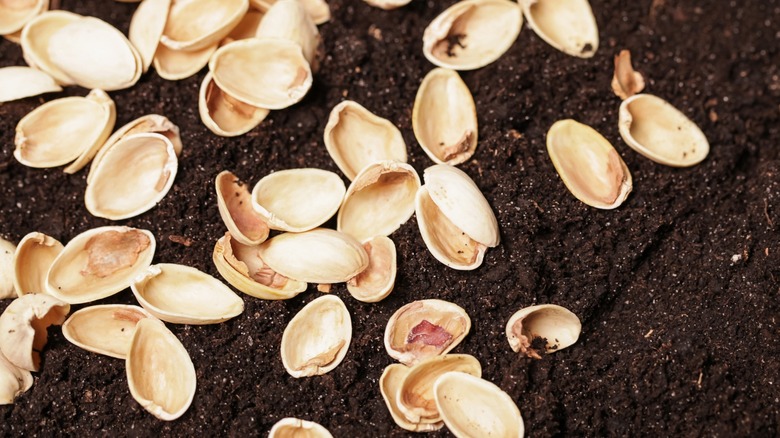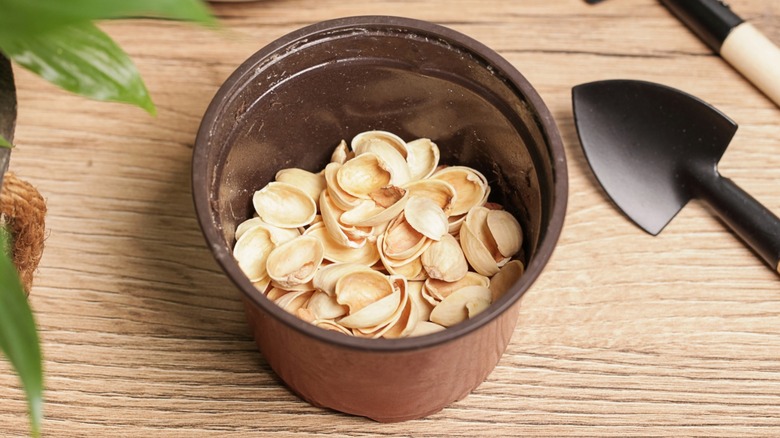Don't Throw Away Pistachio Shells — Use Them To Keep Garden Pests Away
We may receive a commission on purchases made from links.
Have you ever tossed pistachio shells in the trash without a second thought? If so, you're certainly not alone. Similar to sunflower, pumpkin, and walnut shells, the ones cloaking pistachios exist to protect the precious, snackable nuts inside. But these tough little guardian shells are actually more multifunctional than you'd imagine, especially when moving their domain from pantry to garden. Some folks consider them a gardener's secret weapon, especially when it comes to pest control.
Slugs, snails, and other soft-bodied creatures steer clear of pistachio shells when slithering across garden territory. The rigid texture and sharp ridges of crushed shells can harm the pests, so use them to create barriers around your plants, similar to how gardeners use eggshells, pine needles, or diatomaceous earth. Consider placing extra shells closer to plant bases, letting them serve as resilient mulch. This also helps keep weeds away, thereby eliminating hiding spots for little creepy crawlies. For the same reason, it could be beneficial to mix crushed shells with topsoil in strategic places throughout your garden.
Using pistachio shells as mulch can also help regulate moisture in soil, which discourages fungus from growing — subsequently thwarting soil-dwelling bugs that love soggy environments. Unlike traditional organic mulch that quickly breaks down, those tough little shells often take several years to decompose. They're a long-term gift that keeps on giving, helping soil retain just the right temperature and amount of moisture. That's all in addition to the nuts themselves being one of the best nuts to eat for health-enhancing attributes.
More ways resilient pistachio shells stand guard over plants
It feels good knowing that pistachio shells create critter barriers and serve as mulch replacements in buggy environments. But there's even more positive energy tucked inside those sturdy, blonde-hued wonders. Putting the shells to good use is one of many great ways to repurpose kitchen scraps and reduce food waste, bringing sustainability to garden ecosystems. Since pistachio shells do take so long to decompose, they could languish for years in landfills, whereas composting them and recycling the matter into soil pumps up its nutritive value. It also reduces methane emissions and cuts down on chemical fertilizers.
The shells are rich in carbon, contributing to the important "brown" material in a compost bin, bringing balance and beneficial microbes to the party. When they finally break down, the shells gradually release nutrients into the garden, including nitrogen, phosphorus, and potassium. After using this foolproof method for opening stubborn pistachio shells, make sure no nut remnants stay attached, as that can attract the pests you're trying to discourage. And about those red pistachio shells: They're typically colored with chemical-based paints that can wreak havoc on the delicate balance of compost microorganisms.
If the pistachios are salted, you'll also want to thoroughly rinse or soak the shells before using them in your garden. Another way to use pistachio shells outdoors is in potted plants and container gardens. Line pots with crushed shells for a handy drainage layer, allowing future waterings to filter through, potentially preventing dreaded root rot. Doing the same in raised garden beds can prevent weeds — and yes, send pests on their merry little way. If all this talk about the healthy nuts has you hungry, you can order a 2.2-pound bag of Yupik in-shell pistachios on Amazon to get started.

